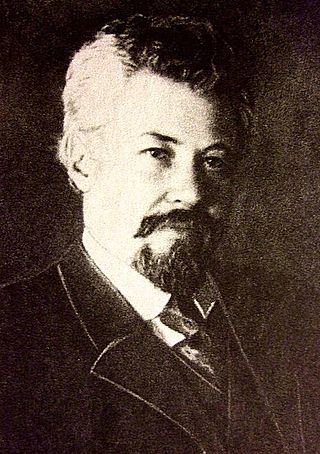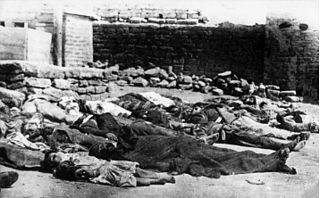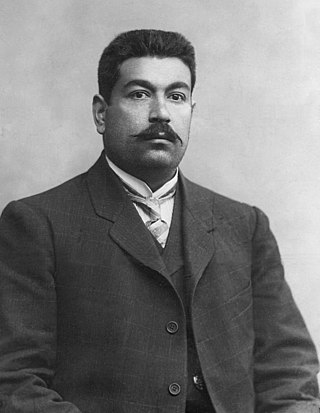Related Research Articles
The Ittihad Party was an Islamist party in the Azerbaijan Democratic Republic that existed from 1917 to 1920. It was formed after the groups Ganja Ittihad-i Islam and Rusyada Muslumanliq merged in September 1917 in opposition to the secular Musavat, and proposed political unity of all of the Muslims within the Russian Empire. In addition to propagating the legalization of the Sharia law within the Muslim communities, the goal of the Ittihadists was to prevent the formation of independent nation-states by the Muslim ethnic groups of the Russian Empire. In 1918, Ittihad won 11 seats in the Azerbaijani parliament, becoming the second largest party in the legislature by number of seats. The Ittihadists' vehement opposition to Musavat, which formed the minority government in Azerbaijan in 1918–1920, led to their collaboration with the White Russians under Anton Denikin. Upon the defeat of the latter, Ittihad started leaning politically towards the approaching Bolsheviks who eventually Sovietized Azerbaijan on 28 April 1920. By that time, the Ittihad leaders had made a statement declaring the fulfillment of their goals and urging their members to join the newly formed Azerbaijan Communist Party. The leader of the party, Dr. Gara Garabeyov, eventually émigrated to Turkey.

Elections to the Russian Constituent Assembly were held on 25 November 1917, although some districts had polling on alternate days, around two months after they were originally meant to occur, having been organized as a result of events in the February Revolution. They are generally recognised to be the first free elections in Russian history.

The Müsavat Party is the oldest existing political party in Azerbaijan. Its history can be divided into three periods: Early Musavat, Musavat-in-exile and New Musavat.

The Azerbaijan Democratic Republic, also known as the Azerbaijan People's Republic, was the first secular democratic republic in the Turkic and Muslim worlds. The ADR was founded by the Azerbaijani National Council in Tiflis on 28 May 1918 after the collapse of the Transcaucasian Democratic Federative Republic, and ceased to exist on April 28, 1920. Its established borders were with Russia to the north, the Democratic Republic of Georgia to the north-west, the Republic of Armenia to the west, and Iran to the south. It had a population of around 3 million. Ganja was the temporary capital of the Republic as Baku was under Bolshevik control. The name of "Azerbaijan" which the leading Musavat party adopted, for political reasons, was, prior to the establishment of the Azerbaijan Democratic Republic in 1918, exclusively used to identify the adjacent region of contemporary northwestern Iran.

The March Days or March Events was a period of inter-ethnic strife and clashes which took place between 30 March – 2 April 1918 in the city of Baku and adjacent areas of the Baku Governorate of the Transcaucasian Democratic Federative Republic.
Azerbaijani National Council was the first delegated legislative body of the Azerbaijan Democratic Republic (ADR) from 27 May 1918 to 17 June 1918 and again from 16 November 1918 to 3 December 1918. It was succeeded by the Parliament, a legislative body formed through nationwide general elections.
The Georgian Socialist-Federalist Revolutionary Party was a Georgian nationalist party, founded in April 1904. The party's program demanded the national autonomy of Georgia, within the framework of a Russian federal state, and advocated for a democratic socialist system. Mainly based in the rural areas, the party's membership was almost entirely drawn from the peasantry and the petty gentry. The political profile of the party had an appeal amongst moderately nationalist intellectuals, schoolteachers and students. The party strived that agricultural issues not be decided by central authorities, but by autonomous national institutions. The party published the periodical Sakartvelo.

The Red Army invasion of Azerbaijan, also known as the Sovietization or Soviet invasion of Azerbaijan, took place in April 1920. It was a military campaign conducted by the 11th Army of Soviet Russia with the aim of installing a new Soviet government in the Azerbaijan Democratic Republic. This invasion occurred simultaneously with an anti-government insurrection organized by local Azerbaijani Bolsheviks in the capital city of Baku. As a result of the invasion, the Azerbaijan Democratic Republic was dissolved, and the Azerbaijan Soviet Socialist Republic was established.

Agha Ashurov was an Azerbaijani statesman who served as Minister of Industry and Trade and Minister of Postal Service and Telegraph of Azerbaijan Democratic Republic, and was member of Parliament of Azerbaijan.

Aslan bey Safikurdski Aghalar bey oghlu, also known as Aslan bey Safikurdlu was an Azerbaijani statesman who served as the Minister of Labor and Justice of Azerbaijan Democratic Republic and Minister of Postal Service and Telegraph of Azerbaijan Democratic Republic, and was member of Azerbaijani National Council and later Parliament of Azerbaijan.

The Declaration of Independence of Azerbaijan is the pronouncement adopted by the Azerbaijani National Council meeting in Tiflis on 28 May 1918, declaring the independence of the Azerbaijan Democratic Republic.
The Azerbaijan Democratic Republic (ADR) is the first independent Republic, proclaimed on May 28, 1918 in the territory of the present Azerbaijan Republic. The republic collapsed on 28 April 1920, after the 11th Red Army entered Baku. On 28 May is celebrated as the Republic Day in Azerbaijan since 1990.

The Syr Darya electoral district was a constituency created for the 1917 Russian Constituent Assembly election. The electoral district covered the Syr-Darya Oblast, except for the Amu Darya Division.

Fergana electoral district was a constituency created for the 1917 Russian Constituent Assembly election. The electoral district covered the Fergana Oblast. Two lists were in the fray in Fergana; List 1 - Muinul Islam Society and List 2 - All-Fergana List of Deputies of Muslim Organizations. Spirin (1987) indicates that List 2 had links to the Socialist-Revolutionary Party. In the autumn of 1917, a meeting of the Muslim National Committee and the Musavat Party had decided to field Mammad Amin Rasulzadeh as their candidate in Fergana.

The Transcaucasus electoral district was a constituency created for the 1917 Russian Constituent Assembly election. The electoral district covered the Baku Governorate, the Elizavetpol Governorate, the Erivan Governorate, the Kutais Governorate, the Tiflis Governorate, the Batum Oblast, the Kars Oblast, the Sukhum Okrug and the Zakatal Okrug.

The Yenisei electoral district was a constituency created for the 1917 Russian Constituent Assembly election. The electoral district covered the Yenisei Governorate. Moreover, the Russian citizens living in the Uryankhay Kray formed part of the constituency.

Parliament of the Azerbaijan Democratic Republic was the legislative branch of the Azerbaijan Democratic Republic. It was the parliament of the first parliamentary republic in the Caucasus Region of Central Asia.

Zeynal Zeynalov — politician, activist and member of Second Duma of Russian Empire in 1907.

The Zangezur uezd was a county (uezd) of the Elizavetpol Governorate of the Russian Empire with its administrative center in Gerusy from 1868 until its formal abolition and partition between the Soviet republics of Armenia and Azerbaijan in 1921. The area of the Zangezur uezd corresponded to most of the contemporary Syunik province of Armenia, and Lachin, Gubadly, Zangilan, and Shusha districts of Azerbaijan.

Aslan bey Vazirzade or Aslan bey Vazirov — one of the students of the Republic, Azerbaijani mineralogist, crystallographer and professor. Honored Scientist of the Azerbaijan SSR, philatelist. For some time, he headed the Azerbaijan Society of Philatelists
References
- ↑ Tadeusz Swietochowski (7 June 2004). Russian Azerbaijan, 1905-1920: The Shaping of a National Identity in a Muslim Community. Cambridge University Press. p. 108. ISBN 978-0-521-52245-8.
- ↑ I̐agub Maḣmudov (2004). Azärbaycan Xalq Cümhuriyyäti ensiklopediyası. Lider Näşriyyat. p. 215. ISBN 9789952417449.
- ↑ Айдын Балаев (1998). Азербайджанское национальное движение в 1917-1918 гг. Елм. p. 126.
- ↑ Richard G. Hovannisian (1967). Armenia on the Road to Independence, 1918 . University of California Press. pp. 108. ISBN 978-0-520-00574-7.
- ↑ Jamil Hasanli (16 December 2015). Foreign Policy of the Republic of Azerbaijan: The Difficult Road to Western Integration, 1918-1920. Routledge. pp. 24–25. ISBN 978-1-317-36617-1.